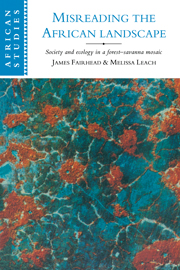Book contents
- Frontmatter
- Contents
- List of plates
- List of figures
- List of tables
- Note on authorship and research collaboration
- Acknowledgements
- Linguistic conventions
- Introduction
- 1 Convictions of forest loss in policy and ecological science
- 2 Forest gain: historical evidence of vegetation change
- 3 Settling a landscape: forest islands in regional social and political history
- 4 Ecology and society in a Kuranko village
- 5 Ecology and society in a Kissi village
- 6 Enriching a landscape: working with ecology and deflecting successions
- 7 Accounting for forest gain: local land use, regional political economy and demography
- 8 Reading forest history backwards: a century of environmental policy
- 9 Sustaining reversed histories: the continual production of views of forest loss
- 10 Towards a new forest–savanna ecology and history
- Appendix I Glossary of plant names
- Appendix II Cassette recordings of oral accounts and discussions
- Notes
- List of references
- Index
- Titles in the series
- Plate section
3 - Settling a landscape: forest islands in regional social and political history
Published online by Cambridge University Press: 05 June 2012
- Frontmatter
- Contents
- List of plates
- List of figures
- List of tables
- Note on authorship and research collaboration
- Acknowledgements
- Linguistic conventions
- Introduction
- 1 Convictions of forest loss in policy and ecological science
- 2 Forest gain: historical evidence of vegetation change
- 3 Settling a landscape: forest islands in regional social and political history
- 4 Ecology and society in a Kuranko village
- 5 Ecology and society in a Kissi village
- 6 Enriching a landscape: working with ecology and deflecting successions
- 7 Accounting for forest gain: local land use, regional political economy and demography
- 8 Reading forest history backwards: a century of environmental policy
- 9 Sustaining reversed histories: the continual production of views of forest loss
- 10 Towards a new forest–savanna ecology and history
- Appendix I Glossary of plant names
- Appendix II Cassette recordings of oral accounts and discussions
- Notes
- List of references
- Index
- Titles in the series
- Plate section
Summary
Perhaps the most striking landscape reinterpretation opened up by examining historical data concerns Kissidougou's forest islands. Forest islands have been represented as natural formations, the epitome of ‘nature’, whether as the relics of a past forest cover, or as more stably associated with particular soil conditions. That they are often found encircling settlements is, from these viewpoints, either due to their selective preservation there amid surrounding deforestation, or because inhabitants have chosen to site their villages where soils already enabled such patches to exist. But while it is true that some forest patches have shrunk or disappeared, and that certain villages were established in pre-existing forest islands, historical evidence suggests that in most cases villagers have formed and extended the patches around their settlements.
Considering forest patches in relationship with settlement, as Kissidougou's villagers do, accounts for their existence, distribution and forms in a way very different from dominant ecological explanations. It is social processes of settlement foundation and habitation which are central to local experiences and representations of forest island ecology. And people's particular positions in these processes – their social identities – can lead them to represent particular aspects of forest islands in particular ways. Initially examining these issues at the scale of particular settlements, the chapter goes on to locate forest island patterns and distribution within aspects of the longer-term dynamics of regional social history, population movements and political culture.
- Type
- Chapter
- Information
- Misreading the African LandscapeSociety and Ecology in a Forest-Savanna Mosaic, pp. 86 - 114Publisher: Cambridge University PressPrint publication year: 1996



